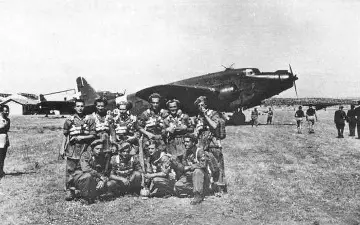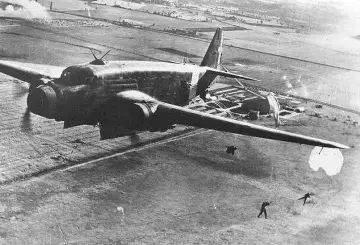This is the brief story of the special paratrooper units of the Italian armed forces and of the operations occurred between 1943 and 1945, fought on opposing sides.
Special paratrooper units
Besides the main Paratrooper units, the Italian armed forces decided to train smaller paratrooper units able to operate as commandos behind the enemy lines.
In summer 1942, the army established the “X Arditi” regiment, comprising different specialities, including a paratrooper battalion.
In early 1942, the Air force established its own paratrooper battalion, originally destined to take part in the invasion of Malta. Subsequently, the battalion grew to regiment size and in November 1942 the A.D.R.A. battalion was formed (Airborne Assault engineers).
The Air Force paratroopers were deployed in Tunisia in the weeks following Operation Torch and participated, along with other units, in several delaying actions that prevented the Allied capture of Bizerte and Tunis in the early days of the campaign. These forces, together with other scattered paratrooper companies of the Italian army continued to fight, as light infantry, until the final axis surrendered in Tunisia in May 1943.
The men of the X Arditi regiment instead, fulfilled their original purpose and participated in a series of missions where they parachuted behind the enemy lines, tasked with destroying bridges and other targets. 5 missions were successful, while 3 failed and 4 were cancelled.

Men of the A.D.R.A. battalion (picture from historicalab.it)
Operation “African airfields”
After the fall of Tunisia, the Italians conceived a bold operation, aimed at hitting 9 large airfields in Allied-controlled Algeria, Tunisia and Libya. They planned to use the highly trained men of the X Arditi regiment and the A.D.R.A. battalion. On the 13th of June 1943, 14 squads (120 men) were parachuted over North Africa. However, many of the S.M.82 carrying the paratroopers missed the landing zones by several kilometres. Once the paratroopers touched the ground, far away from their targets, new troubles began. Most of the squads were intercepted or captured by allied patrols in the first days. Only two saboteurs, Vito Procida and Francesco Cargnel managed to penetrate the Benina airfield (near Bengasi) and planted around 20 explosive charges that detonated in the night between the 18-19th June, allegedly destroying 25 aircraft. This small success however did not cancel the overall failure of the Operation.

Training launch from a S.M.82 (picture from historicalab.it)
The “Nembo” Division
After the Folgore, a second full paratrooper division was formed, this was the 184° “Nembo”. The division was ready in early 1943 and one of its battalions participated in anti-partisan operations at the border between Italy and Yugoslavia (occupied by the Axis). Facing the prospect of an Allied invasion, the bulk of the Nembo Division was redeployed in Sardinia while one of its regiments (the 185°) reached the southern region of Apulia.
The 185° regiment did not participate in the defence of Sicily but faced the Allies once they landed in Calabria in early September. Here, the paratrooper regiment of the Nembo clashed with the 1st Canadian division until the 8th of September, the day on which the Italian authorities proclaimed the armistice with the Allies. The clashes between the Nembo and the Canadians are probably the last fights that occurred between Allied and Italian units (of the Kingdom of Italy) before the end of the hostilities.
The Armistice
The armistice and the events that unfolded in the following hours caused general disarray in the ranks of the Army. The bulk of the Nembo division deployed in Sardinia saw the defection of an entire battalion, these men decided to continue the war alongside Germany and withdrew with the 90° Panzergrenadier division towards Corsica. Here they even clashed with their compatriots, that tried to stop the Germans.
Also, the 185° regiment in Calabria saw the defection of an entire Battalion which fled north with the Germans, while the rest of the unit surrendered to the Canadians on the 11th of September.
Mussolini’s new paratroopers
Following the liberation of Mussolini, the Germans installed a puppet Government, led by the former Duce, in the Italian territories not yet liberated by the Allies. Between October and November 1943, remnants of the Nembo division that had joined the Germans, together with some new volunteers, formed a new unit, the autonomous group “Nembo”, consisting of 3 battalions. This was in practice one of the very first combat units of the new Fascist Republic.
The paratroopers underwent further reorganization and re-equipment, some of them even trained at the paratrooper school of Freiburg, in Nazi Germany. When the Allies landed at Anzio in January 1944, the Germans realized that there were no forces available in the area and no obstacles laid between the landing areas and Rome. Various units were hastily ordered to converge in the area and create a perimeter around the beachheads, Among them, the Germans deployed a Battalion of the Nembo group. These men actively participated in the Anzio campaign as stormtrooper and scout companies of the 4th Fallschirmjäger division. In February, the Germans launched a counterattack against the Allied positions, hoping to push them back into the sea. The “Nembo” paratroopers saw intense fighting but, after 5 days, the offensive was called off. They remained in the area, reinforced by other battalions, until the decisive push northwards of the Allies and the liberation of Rome.

A man of the Nembo battalion together with German paratroopers in the Anzio area
For the remainder of the war, the Paratrooper of Mussolini’s republic saw action in anti-partisan operations in the north of Italy. They also fought in the Western Alps, trying to fend off the advance of the Free-French forces.
Co-belligerent Paratroopers
After the armistice, those that remained loyal to the King and the legitimate government slowly gathered in Southern Italy and formed the “Italian Liberation Corp” (Corpo Italiano di Liberazione) fought alongside the allies until the end of the war. Men from the former division Nembo constituted two regiments that progressively advanced north with the British 8th Army through the Italian peninsula, on the Adriatic (eastern side). They distinguished themselves in several bloody clashes and even took part in the last paratrooper operation that occurred in the theatre, Operation Herring.

Italian paratroopers participating in Operation Herring
The war experience, coupled with the precious training obtained by the Allies, proved to be instrumental in the rebirth of paratrooper units after the war.
Sources
Ciavattone, F. (2022). PARACADUTISTI! Storia delle Aviotruppe Italian. STORIA MILITARE Dossier n.61.
Jowett, P. (2019). L’esercito italiano nella seconda guerra mondiale. LEG edizioni.
Saccoman, A. (2007). La campagnia d’ Italia.